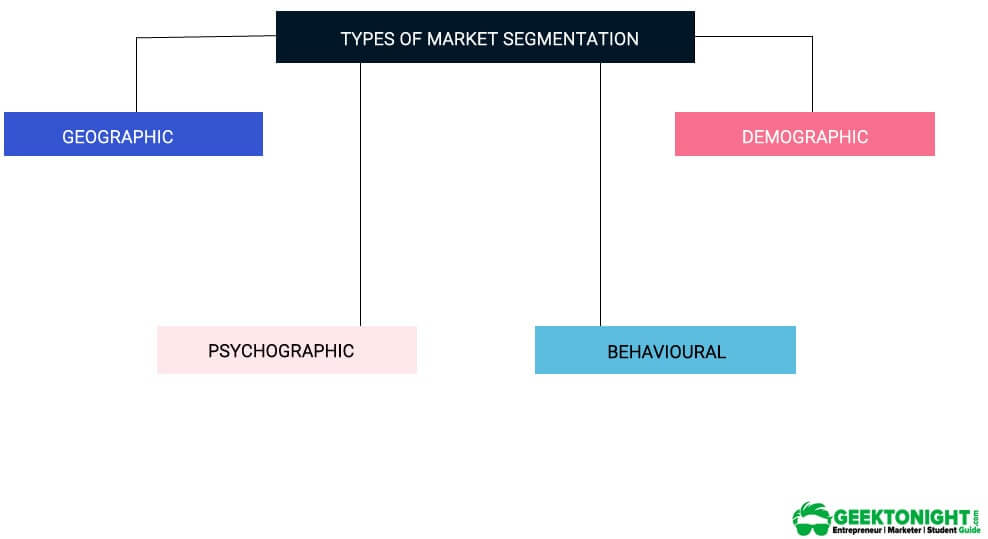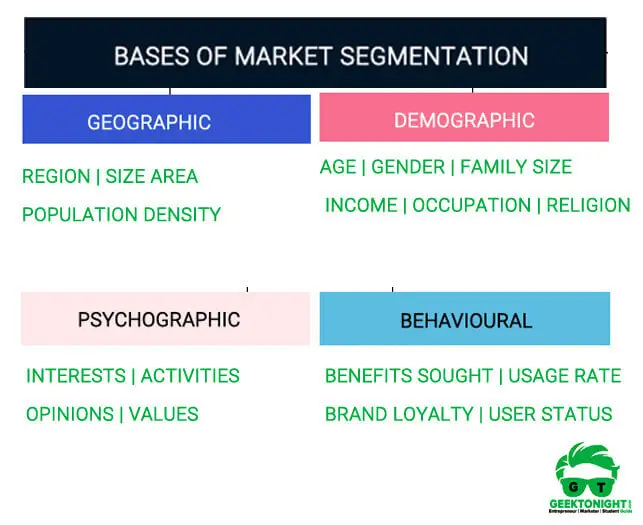What is Market Segmentation?
Market segmentation is the process of dividing a total market into market groups consisting of people who have relatively similar product needs, tastes, and preferences. The purpose is to design a marketing mix strategy that more precisely matches the needs of individuals in a selected market segment(s).
Market segmentation is the technique used to enable a business to better target its products at the right customers. It is about identifying the specific needs and wants of customer groups and then using those insights into providing products and services which meet customer needs.
Table of Content
- 1 What is Market Segmentation?
- 2 What is Market?
- 3 Market Segmentation Definition
- 4 Objectives of Market Segmentation
- 5 Types of Market Segmentation
- 6 Bases of Market Segmentation
- 7 Bases for Consumer Market Segmentation
- 8 Market Segmentation Process
- 9 Importance of Market Segmentation
- 10 Examples of market segmentation
- 11 What is the Target Market?
- 12 Marketing Management Topics

What is Market?
Market is a place where trade activity is carried on. It means buying and selling goods. Market refers to a huge number of audience, thus market segmentation is done and the selected segment is targeted and a product is been positioned.
Market Segmentation Definition
Market Segmentation is the sub-dividing of a market into homogeneous subsets of customers, where any subset may conceivably be selected on a market target to be reached with a distinct marketing mix. – Philip Kotler
Market Segmentation consists of taking the total heterogeneous market for a product and dividing into several sub-markets or segments, each of which tends to be homogeneous in all significant aspects. – William J. Stanton
Objectives of Market Segmentation
In general, segmentation has the main objective to improve the competitive position of businesses. It provides better service to consumers. In addition to these main objectives are—boost sales, improve market share, to communicate, better promotion, and strengthening the image.
At least there are five advantages to be gained by doing market segmentation, namely:
- Designing Products that are More Responsive to Market Needs: The company puts the customer in the first place, and adjusts products to satisfy them and achieve customer satisfaction at a profit.
- Analyze Market: Segmentation market is helping executives to detect anyone who attacked its product market.
- Assess Opportunities: After analyzing the market, companies that master the concept of segmentation will be on the lookout for the idea to find opportunities. This opportunity is not always something that big, but in its time would be great.
- Mastering the Position of Superior and Competitive: A company that controls segments well is generally well aware of their customers. Companies understand the shifts that occurred in the segment.
- Determining Effective Communication Strategies: After learning about the targeted segment, the company will determine how to communicate effectively with the targeted segments.
Types of Market Segmentation
There are 4 different types of market segmentation and those are discussed below:
- Geographic Segmentation
- Demographic Segmentation
- Psychographic Segmentation
- Behavioural Segmentation

Geographic Segmentation
Geographic segmentation divides the market into geographical units such as nations, states, regions, counties, cities.
The organisation can choose to operate in one or more area and pay special attention to local variation. In that way, it can tailor marketing programs to the needs and wants of the local customer.
The geographic segmentation is furthermore useful when there are differences in a location where a product is marketed. The differences can be caused by cultural factors, traditions, politics etc.
Demographic Segmentation
In demographic segmentation, the market is divided on variables such as age, family size, family life cycle, gender, income, occupation, education, religion, race, generation, nationality, and social class.
One reason demographic variables are so popular with marketers is that they’re often associated with consumer needs and wants. Variables are easy to identify and measure.
Psychographic Segmentation
In psychographic segmentation, buyers are divided into different groups on the basis of psychological/personality traits, lifestyle, or values.
People within the same demographic group can exhibit very different psychographic profiles. Psychological profiles are often used as a supplement to geographic and demographics when these do not provide a sufficient view of customer behaviour.
Behavioural Segmentation
In behavioural segmentation, marketers divide buyers into groups on the basis of their knowledge of, attitude toward, use of, or response to a product.
It considers variables like brand loyalty and the usage rate of the consumer.
Also Read: What is an Entrepreneurship
Bases of Market Segmentation
Bases of market segmentation are the factors that are used to divide the market into a small homogeneous market.

- Geographic Segmentation: It includes the following variables:
- Region: Continent, Country, State
- Size of metropolitan area: Segmented according to population size
- Population Density
- Climate
- Demographic Segmentation: It includes the following variables:
- Age
- Gender
- Family Size
- Family Life Cycle
- Income
- Occupation
- Education
- Generation
- Ethnicity
- Nationality
- Religion
- Social Class
- Psychographic Segmentation: It includes the following variables:
- Interests
- Activities
- Opinions
- Values
- Attitudes
- Behavioural Segmentation: Behavioural Segmentation is based on actual customer behaviour towards products. Some behavioural variables include:
- Benefits Sought
- Usage Rate
- Brand Loyalty
- User Status
- Readiness to buy
- Occasions
Bases for Consumer Market Segmentation
Market segmentation can be done on two bases, i.e., consumer mar- ket and business market. Consumer market includes the final users of the products or services who normally make a purchase in smaller quantities.
Consumer market segmentation refers to the process of dividing and grouping the consumers on the basis of some common characteristic. There are four variables which are considered in consumer market segmentation:
Demographic factors
The study of population is called demography. Demographic factors include age, gender, education, religion, etc. The demographic factors are used to segment market mainly by the organisations who deal with consumer goods such as tea, soap, detergents, etc. Some of the demographic variables are:
Age: The market can be divided into segments on the basis of age of the customer. An elderly person has different needs, taste and preferences as compared to a child. For example, a garment shop has multiple segments for different age groups such as kids or teenagers.
Gender: There are many products which are consumed by people based on their gender. Females buy cosmetic products such as nail paints, lipsticks and bangles, whereas males buy products such as shaving blades, cream, or razor.
Income: The income of customers are also considered as a variable for segmenting the market. In accordance with the income of the customers, the organisation makes products for low-income group, medium-income group and high-income group.
Occupation: The lifestyle and buying habits of people depends on their occupations such as lawyers, doctors, engineers or teachers.
Education: The education of the customers (uneducated, educated, graduate, Masters) is also a variable which is used for segmenting the market. Magazines, novels, books are published by keeping the educational factor into consideration.
Religion: The religion of the consumers may also be taken as the basis for segmenting the market. For example organisations manufacturing products such as camphor, dhoop, agarbatti may target the Hindu community while those manufacturing candles may target the Christian or Buddhist communities.
Geographic factors
The geographical factors are considered important in market segmentation. An organisation makes the product to satisfy the needs of people who belong to particular area, city, state and country.
Let us understand this with the help of an example, In Delhi’s PVR, movies play in Hindi and English language, whereas, in Bengaluru’s PVR, movies are played in Hindi, English, Kannada, Tamil and Telugu language.
Psychographic factors
Psychographic segmentation involves seg- mentation on the basis of lifestyles, values and beliefs of an indi- vidual. People prefer to purchase those products or services that give them satisfaction and suit their values. Various factors that come under psychographic segmentation are as follows:
- Lifestyle: It differentiates people based on their habits, incomes and social status. People always purchase those products which suit and match with their lifestyles. It is easier to find the difference between the lifestyle of people who belong to urban and rural areas.
For instance, people living in the urban and rural areas may have similar needs and wants but their choices of brands and sometimes even products are different as per their lifestyles. - Personality: It refers to segmenting the market on the basis of individuals’ personality traits that determine their buying behaviours. Organisations try to match the offered products or services with the personalities of the target market segments.
For example, Soft Drink Company such as Mountain Dew is promoted with a message of becoming fearless and tough. It uses the punch line ‘Dar Ke Aage Jeet Hai,’ to target individuals with aggressive and risk-taking attitudes. - Values: They are connected with the thoughts and beliefs of customers, which may influence the attitudes of customers towards the product in the long run. These are important to develop communication programmes that affect the thoughts of customers.
For example, TV serials and movies are often based on value-based customer segmentation. Most Indian television soaps convey the importance of Indian cultural values and focus on the joint family concept.
Behavioural factors
The segmentation based on customers’ behaviour towards a product is behavioural market segmenta- tion. The behavioural factors help the organisation to understand consumers based on their previous patterns.
This variable is very helpful to segment customers especially when these customers purchase products regularly from the organisation. Following are the variables which can be used for segmenting the market on the basis of behaviour:
Market Segmentation Process
Market segmentation itself is a process of grouping and sub-grouping a large heterogeneous market of the audience into similar qualities and attributes.
This helps the companies concentrate on a specified group of customers they want to target which will help them gain a competitive advantage over their competitors in the market and ultimately help them gain profit.
Using market segmentation the marketers can easily customize their marketing strategies. It narrows the risk of ineffective marketing strategies and chooses the right type of market segment that would suit their marketing strategies.
Benefits: They refer to the advantages of the product for customers. The benefits of the product attract customers to purchase the product on a regular basis.
Occasions: These are the special events that are considered to divide the customers according to their purchase requirements in different occasions as Cadbury has launched Celebration’s Rich Dry Fruit Collection for festive offering for its customers.
Usage rates: Usage rates classify customers according to their usage of the product i.e. they can be heavy, medium or light users. Organisations pay attention on those users who require products for heavy and medium uses. For example, some organisations provide membership to their regular cus- tomers so that they can avail discounts on purchasing large or medium quantity.
Loyalty status: The marketers analyse customers according to different loyalty status and apply a suitable marketing strategy. For example, Citibank offers different balance transfer options at a lower rate of interest on its credit cards to attract loyal customers of other banks.
Importance of Market Segmentation
One of the most importance of market segmentation is that it allows an organization to precisely reach a consumer with specific needs and wants.
Other importance of market segmentation is discussed below:
- Adjustment of product and marketing appeals
- Better position to spot marketing opportunities
- Allocation of marketing budget
- Effective competition with rivals
- Effective marketing programme
- Evaluation of marketing activities
Adjustment of product and marketing appeals
Market segmentation presents an opportunity to understand the nature of the market. The seller can adjust his thrust to attract the maximum number of customers by various publicity media and appeals.
Better position to spot marketing opportunities
The producer can make a fair estimate of the volume of his sale and the possibilities of furthering his sales. In the regions where response of the customers is poor, the strategy of approach can be readjusted accordingly to push the sale.
Allocation of marketing budget
It is based on market segmentation that marketing budget is adjusted for a particular region or locality. In the place where the sales are limited, it is no use allocating a huge budget.
Effective competition with rivals
It helps the producer compete with his rivals effectively. The producer can adopt different strategies for different markets taking into account the rivals strategies.
Effective marketing programme
It also helps the producer to adopt an effective marketing programme and serve the consumer better at comparatively low cost. Different marketing programmes can be used for different segments.
Evaluation of marketing activities
Market segmentation helps the manufacturer to find out and compare the marketing potentialities of the products. It helps to adjust production and using resources in the most profitable manner. As soon as the product becomes obsolete, the product line could be diversified or discontinued.
Examples of market segmentation
Example of geographic segmentation
McDonald is an example of geographic segmentation. It customizes its menu that varies from country to country. McDonald’s has introduced burgers with no beef or no pork in it for India. And likewise in Mexico, more chilli sauce is used.
KFC in India concentrates on veg products in south India and on chicken products in North India.
Example of demographic segmentation
Ferrero SpA an Italian manufacturer of branded chocolate is an example of demographic segmentation. Its sub-brand kinder manufacture chocolate specially for children and has also separate colours and toys for girls and boys.
Example of psychographic segmentation
Rolls Royce is an example of psychographic segmentation, it targets the consumer having the potential of buying luxury cars and having a rich lifestyle. It concentrates on the variable of the lifestyle of the consumer.
Example of behavioural segmentation
Airlines, hotel and such industry are the example of behavioural segmentation.
Emirates airlines are the best example for it, it offers excellent services to the passengers which helps them retain the customer.
It creates brand loyalty and make the customer loyal to their airlines and fly with them frequently.
Also Read: 4Ps of Marketing Mix
What is the Target Market?
Target market is a group of audience within which the company is planning to sell its products. It is a process after market segmentation is done, a marketer has to select one or more segments in which a marketer has to implement his marketing strategies.
The target market consists of consumers who have similar characteristics who are more likely to buy the products which will be more profitable for the company.
After the selection of one or more market segments, the marketer has to implement its marketing strategies. It has to modify the marketing mix (4Ps) as per the needs to reach to the customer.
After a target market is selected marketer needs to position its product to the selected segment of the customers.
Go On, Share & Tell Us What You Think!
Did we miss something in Marketing Management Tutorial or You want something More? Come on! Tell us what you think about our post on Market Segmentation | in the comments section and Share this post with your friends.
Marketing Management Topics
Marketing Management
(Click on Topic to Read)
- What Is Market Segmentation?
- What Is Marketing Mix?
- Marketing Concept
- Marketing Management Process
- What Is Marketing Environment?
- What Is Consumer Behaviour?
- Business Buyer Behaviour
- Demand Forecasting
- 7 Stages Of New Product Development
- Methods Of Pricing
- What Is Public Relations?
- What Is Marketing Management?
- What Is Sales Promotion?
- Types Of Sales Promotion
- Techniques Of Sales Promotion
- What Is Personal Selling?
- What Is Advertising?
- Market Entry Strategy
- What Is Marketing Planning?
- Segmentation Targeting And Positioning
- Brand Building Process
- Kotler Five Product Level Model
- Classification Of Products
- Types Of Logistics
- What Is Consumer Research?
- What Is DAGMAR?
- Consumer Behaviour Models
- What Is Green Marketing?
- What Is Electronic Commerce?
- Agricultural Cooperative Marketing
- What Is Marketing Control?
- What Is Marketing Communication?
- What Is Pricing?
- Models Of Communication
Sales Management
- What is Sales Management?
- Objectives of Sales Management
- Responsibilities and Skills of Sales Manager
- Theories of Personal Selling
- What is Sales Forecasting?
- Methods of Sales Forecasting
- Purpose of Sales Budgeting
- Methods of Sales Budgeting
- Types of Sales Budgeting
- Sales Budgeting Process
- What is Sales Quotas?
- What is Selling by Objectives (SBO)?
- What is Sales Organisation?
- Types of Sales Force Structure
- Recruiting and Selecting Sales Personnel
- Training and Development of Salesforce
- Compensating the Sales Force
- Time and Territory Management
- What Is Logistics?
- What Is Logistics System?
- Technologies in Logistics
- What Is Distribution Management?
- What Is Marketing Intermediaries?
- Conventional Distribution System
- Functions of Distribution Channels
- What is Channel Design?
- Types of Wholesalers and Retailers
- What is Vertical Marketing Systems?
Marketing Essentials
- What is Marketing?
- What is A BCG Matrix?
- 5 M'S Of Advertising
- What is Direct Marketing?
- Marketing Mix For Services
- What Market Intelligence System?
- What is Trade Union?
- What Is International Marketing?
- World Trade Organization (WTO)
- What is International Marketing Research?
- What is Exporting?
- What is Licensing?
- What is Franchising?
- What is Joint Venture?
- What is Turnkey Projects?
- What is Management Contracts?
- What is Foreign Direct Investment?
- Factors That Influence Entry Mode Choice In Foreign Markets
- What is Price Escalations?
- What is Transfer Pricing?
- Integrated Marketing Communication (IMC)
- What is Promotion Mix?
- Factors Affecting Promotion Mix
- Functions & Role Of Advertising
- What is Database Marketing?
- What is Advertising Budget?
- What is Advertising Agency?
- What is Market Intelligence?
- What is Industrial Marketing?
- What is Customer Value
Consumer Behaviour
- What is Consumer Behaviour?
- What Is Personality?
- What Is Perception?
- What Is Learning?
- What Is Attitude?
- What Is Motivation?
- Segmentation Targeting And Positioning
- What Is Consumer Research?
- Consumer Imagery
- Consumer Attitude Formation
- What Is Culture?
- Consumer Decision Making Process
- Consumer Behaviour Models
- Applications of Consumer Behaviour in Marketing
- Motivational Research
- Theoretical Approaches to Study of Consumer Behaviour
- Consumer Involvement
- Consumer Lifestyle
- Theories of Personality
- Outlet Selection
- Organizational Buying Behaviour
- Reference Groups
- Consumer Protection Act, 1986
- Diffusion of Innovation
- Opinion Leaders
Business Communication
- What is Business Communication?
- What is Communication?
- Types of Communication
- 7 C of Communication
- Barriers To Business Communication
- Oral Communication
- Types Of Non Verbal Communication
- What is Written Communication?
- What are Soft Skills?
- Interpersonal vs Intrapersonal communication
- Barriers to Communication
- Importance of Communication Skills
- Listening in Communication
- Causes of Miscommunication
- What is Johari Window?
- What is Presentation?
- Communication Styles
- Channels of Communication
- Hofstede’s Dimensions of Cultural Differences and Benett’s Stages of Intercultural Sensitivity
- Organisational Communication
- Horizontal Communication
- Grapevine Communication
- Downward Communication
- Verbal Communication Skills
- Upward Communication
- Flow of Communication
- What is Emotional Intelligence?
- What is Public Speaking?
- Upward vs Downward Communication
- Internal vs External Communication
- What is Group Discussion?
- What is Interview?
- What is Negotiation?
- What is Digital Communication?
- What is Letter Writing?
- Resume and Covering Letter
- What is Report Writing?
- What is Business Meeting?
- What is Public Relations?
Business Law
- What is Business Law?
- Indian Contract Act 1872
- Essential Elements of a Valid Contract
- Types of Contract
- What is Discharge of Contract?
- Performance of Contract
- Sales of Goods Act 1930
- Goods & Price: Contract of Sale
- Conditions and Warranties
- Doctrine of Caveat Emptor
- Transfer of Property
- Rights of Unpaid Seller
- Negotiable Instruments Act 1881
- Types of Negotiable Instruments
- Types of Endorsement
- What is Promissory Note?
- What is Cheque?
- What is Crossing of Cheque?
- What is Bill of Exchange?
- What is Offer?
- Limited Liability Partnership Act 2008
- Memorandum of Association
- Articles of Association
- What is Director?
- Trade Unions Act, 1926
- Industrial Disputes Act 1947
- Employee State Insurance Act 1948
- Payment of Wages Act 1936
- Payment of Bonus Act 1965
- Labour Law in India
Brand Management




